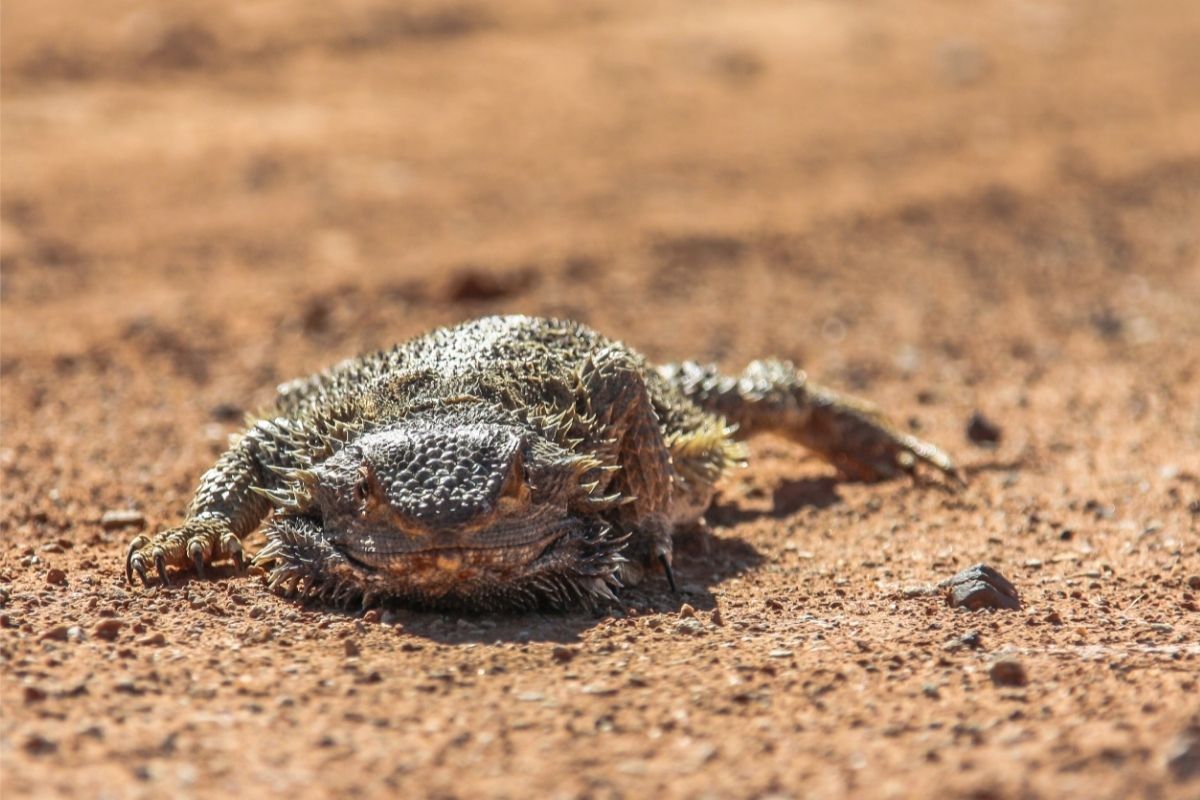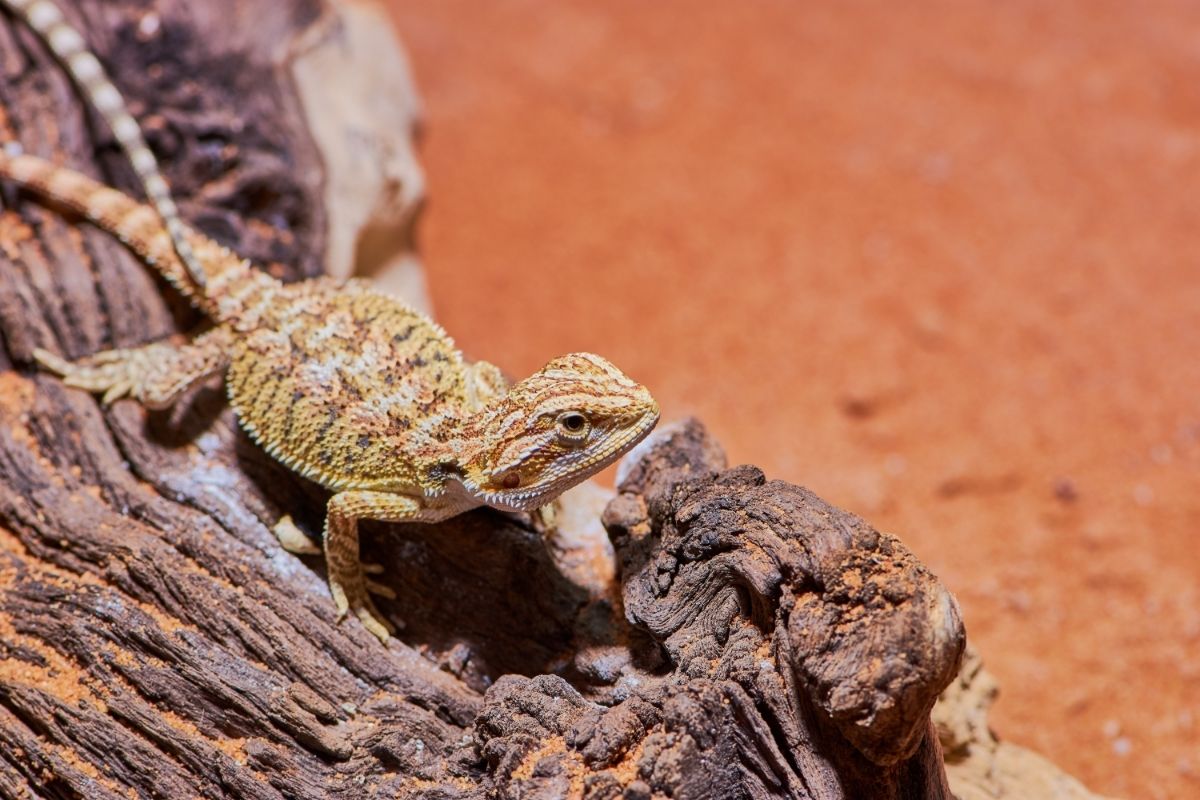Bearded Dragons are very interesting creatures. If you’ve ever owned a bearded dragon, then you know that they can go a fairly long time without drinking water.
However, it’s absolutely critical for any bearded dragon owners or anyone who is interested in buying a bearded dragon to understand how bearded dragons stay hydrated.

That means understanding how long a bearded dragon can go without water is absolutely necessary.
While bearded dragons are creatures of the desert, they can still become dehydrated, which can cause serious problems and, ultimately, result in death.
So, if you’re ready to learn about bearded dragons and how often they can go without drinking, keep reading!
We explain all about bearded dragons and keeping them hydrated, as well as explain signs of dehydration.
The Basics: Do Bearded Dragons Need To Consume Water?
This is very obvious, but it’s best to start off with the basics: bearded dragons absolutely need water to survive.
Like any other animal, they need water, and food, to survive. Bearded dragons that do not have access to water will eventually become ill and die.
So while these are certainly interesting creatures that do not need to drink as much as other animals, they need to consume water in order to live.
So, How Long Can A Bearded Dragon Go Without Drinking Any Water?
Bearded dragons can, in fact, go a fairly long time without drinking water. This is because the bearded dragon is biologically adjusted to a certain climate.
The bearded dragon needed to adjust to a particular climate in order to survive the particular nature of that climate.
Now, a bearded dragon is adjusted to a very dry and hot climate because they originate from Australia. They particularly grew within the deserts of Australia, which means they lived in extreme climates.
In a desert, there are very few sources of water, so any creature — and even plants — need to be able to thrive without frequently drinking water.
If the bearded dragon needed to drink water every single day, then it would be very difficult for the bearded dragon to survive because water sources were limited in the climate they originated from.
While some bearded dragons can appear domesticated now, they are still products of their original environment, which is why a bearded dragon needs to exist within a very precise climate. Otherwise, they can become very unwell.
It is difficult to say the precise amount of time a bearded dragon can go without drinking water, as each bearded dragon may have different requirements.
However, in the wild, bearded dragons can typically survive between three days, to three weeks, without drinking water.
That does not mean a bearded dragon is healthy during this period, it simply means the bearded dragon has a chance of survival if it can get to a water source.
The bearded dragon will experience signs of dehydration, and this will only worsen as each day passes.
If a bearded dragon is domesticated, it is the owner’s responsibility to ensure that the bearded dragon has enough water to drink.
On average, a bearded dragon should obtain 10ml of water every day, which can be derived from the water itself, and food sources.
How Do Bearded Dragons Get Water?

Bearded dragons do not consume water the same way mammals consume water because they are a reptile.
As already stated, bearded dragons adapted to their environment and, as a result, can get their source of water through different methods.
Drinking
A bearded dragon ‘drinks’ by placing their mouths in water and then licking, much like a dog or a cat. This provides direct access to the water.
For mammals, this is the best way for them to drink water. That’s why cats and dogs are happy to drink water that way because it’s natural for them.
For the bearded dragon, it actually isn’t the best way for them to consume water. That’s because, in the desert, there is very little standing water.
Bearded dragons in captivity have standing water, so they can drink in this method. A bearded dragon should always have a shallow dish of water, which is fresh and clean, so they can drink when needed.
The water should never be deeper than the bearded dragon’s shoulder, and it should be big enough to fit the body of the bearded dragon.
That’s because a bearded dragon usually prefers to submerge itself in the water rather than drink from the water directly. They will either drink from the water or use their vent to drink water.
The Vent
The vent is an opening at the base of a bearded dragon’s tail. It is the place where a bearded dragon defecates, but it also serves another purpose.
The vent can allow bearded dragons to absorb water if they need to. The bearded dragon cannot consume water through their skin, so bathing does not make them hydrated.
It is only through the vent that a bearded dragon can drink water unless the bearded dragon uses its mouth.
Eating
Eating is a very common way that bearded dragons hydrate themselves, especially in the wild.
While insects do not have a lot of water, other live food, including phoenix worms, does offer a lot of hydration to the bearded dragon.
Bearded dragons can also eat vegetables and fruits. Bearded dragons in captivity usually eat greens because they offer some levels of hydration, although not a high amount.
Fruits and vegetables, however, are very common and necessary for hydration.
What Are The Signs of Dehydration In Bearded Dragons?
There are a couple of signs that suggest a bearded dragon may be dehydrated. If you own a bearded dragon and you are worried about dehydration, you could consult a vet. Dehydration is very serious and dangerous and can result in death.
Eyes That Are Sunken In
A sign of dehydration in bearded dragons is eyes that have become sunken in. For those who own a bearded dragon, or those who work with reptiles, this is easy to detect.
It is a very visible sign that there is something wrong with the bearded dragon, and it is often the result of dehydration.
If this occurs, bearded dragon owners should consult a vet, as it could be due to another medical reason.
Skin That Is Wrinkled
This is one of the easiest ways of noticing dehydration in bearded dragons, and it tends to be one of the first signs.
Wrinkled skin is a clear sign of dehydration, but it’s important to remember that younger bearded dragons, they do tend to have skin that is more wrinkled.
A good way to tell whether the bearded dragon is possibly dehydrated is to pinch the skin of the dragon (gently) and then release the skin.
If the skin returns to its original position, it may not be dehydrated. If the skin does not return to its position immediately, it’s very likely that it could be dehydrated.
Urates That Are Dark
If a bearded dragon produces urates that are dark, then this could be a sign of dehydration.
A urate is something that is produced along with the bearded dragon’s deification, so it will come out when the bearded dragon defecates. The urate is always white.
If the urate is a darker color, such as orange or yellow, instead of white, then this could be a sign of dehydration.
If any of these symptoms occur with a bearded dragon, it is vital that the bearded dragon is taken to the vet.
The vet will be able to assess what is wrong with the bearded dragon and will be able to rehydrate the bearded dragon safely.
Frequently Asked Questions
How Much Water Should a Bearded Dragon Drink Daily?
A bearded dragon should drink around 10ml of water per day.
Fresh and clean water should always be provided. While in the wild, bearded dragons can survive for a period of time without water, which is very dangerous for them.
Freshwater should always be provided for bearded dragons in captivity, along with fresh fruits, vegetables, and insects.
Can Bearded Dragons Drink Water Through Their Skin?
No, this is a popular myth, but bearded dragons cannot drink water through their skin.
A bearded dragon can get water through their vent, but that is only if the bearded dragon is submerged in a safe amount of water.
Why Do People Mist Their Bearded Dragon’s Food?
Misting a bearded dragon’s food is very helpful because it will help them stay hydrated.
It does depend on the type of fruit and vegetables that are misted and how much water the vegetables or fruit can retain. However, ensuring the bearded dragon is consuming water is a very good idea.
Summary
Bearded dragons need to consume 10ml of water every day.
While it is true that bearded dragons can survive from between three days, to three weeks, in the wild without drinking, it is very dangerous for them.
They will suffer from extreme dehydration, which can result in death. The amount of time a bearded dragon can survive without water will also depend on the animal itself.
In captivity, a bearded dragon should not go without clean and fresh water. It is vital for the health of the bearded dragon that it does not experience dehydration.
